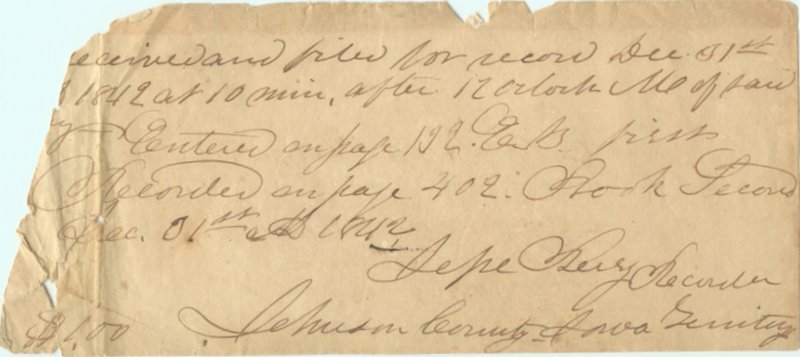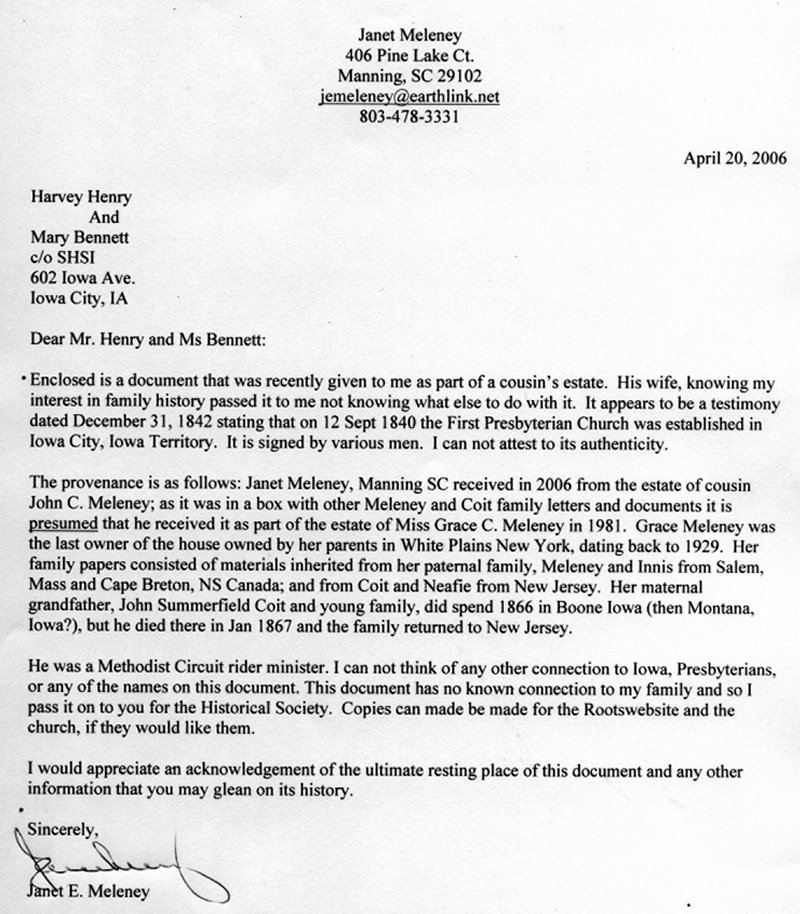April 26, 2006 First Presbyterian
Church Mary Bennett Letter of Transmittal Certification that on the 12th of September 1840 a church was organized in Iowa City Iowa Territory to be known by the name of the “First Presbyterian Church of Iowa City.” This
document was provided by Janet E. Meleney whose cover letter is
attached. The
original of this document is being delivered to Mary Bennett of the ISHS. A
copy is being sent by U. S. Mail to the First Presbyterian Church at the
above address. The
names of the presiding ministers, the pastor, elders, and deacons are
included. The
signatures of four trustees are shown including that of Chauncey Swan. For
the ICGS H
a r
v e y
W. H
e n r
y CC Janet
E. Meleney Certification
document Certificate
of Organization
Notes by Bob Hibbs, Iowa City
Historian: 1.
Although
Chauncey Swan had been instrumental in 1839 in setting aside several
parcels on his original plat of Iowa City to be given to churches who
would build an edifice with a value of at least $1,000 within three
years, his Presbyterian Church never applied.
Rather, it accepted as a gift from Swan and his wife, Dolly, the
lot on which it originally built – now occupied by the 1865 Old Brick
Church at Clinton and Market streets a block north of Old Capitol. The
lot was valued at $100 at the time. 2.
The
names on the certificate are of the following: a.
Rev.
Lancelot Graham Bell, known in the church as “The Father of
Presbyterianism in Iowa.” Schuyler
Presbytery in Illinois sent him forth in fall 1836 “to form
churches wherever it may be found expedient on the west of the
Mississippi.” He
organized 28 congregations including the one in Iowa City before his
death in 1868. b.
Rev.
Michael Hummer, colorful first pastor of the church from 1841 to
1848, he had been sent by Schuyler Presbytery to consecrate the new
church. No church was built
during his pastorate, with the small congregation meeting wherever it
could find quarters, including Old Capitol and the Mechanics Academy. After a church was dedicated in 1850, Rev. Hummer returned
from Muscatine to take a bell he claimed was due him for lost wages, was
stranded in the belfry when members took away his ladder, and was forced
to depart without the bell. Hidden
in a creek, it later was retrieved, taken west as far as Salt Lake City,
where it was sold to the Mormon Church. c.
John
McConnell, a farmer in Clear Creek Township west of Iowa City, he was
a widower who raised a family of seven daughters and three sons. d.
Diodate
Holt, a farmer who returned to his home state of Kentucky in
1845. e.
Chauncey
Swan, the father of Iowa City who as a lead miner had been
elected to the territorial legislature meeting in Burlington by fellow
Dubuque voters. Iowa’s
first governor, Robert Lucas, appointed Swan to head a three-member
committee that included Robert Ralston and John Ronalds to select a site
for a capital. After
picking the site, Swan hired surveyors to lay out and stake the original
square mile of Iowa City between Court and Brown streets, and from
Summit Street west to the far bank of the Iowa River, including the
Hancher Auditorium site. He
then managed construction of Old Capitol through its torturous
beginning. His daughter
Cordelia died in 1839 at age five and became the first burial in Oakland
Cemetery. His wife Dolly
died in February 1847, and when the California gold rush ensued in 1849,
he joined in. During a
return voyage around South America, he died at sea in 1852 and was
buried in New York Harbor. Two
of three Swan sons, Silas at age 25 and Charles at age 27, were married
in the church to sisters Eliza and Angelina Moore. f.
Joseph Schell, a merchant who owned in a
small frame house where the Congregational Church now stands at
Jefferson and Clinton streets a block south of Old Brick. g.
George
J. Huey, a pioneer Washington Street merchant who was active in an
early group who saw to maintenance of that street during the period
before the formation of city government in 1853. h.
Theodore
Sanxay, a pioneer hardware merchant who moved his business to the
northeast corner of Clinton and Washington streets in 1850, built a
second building adjoining in 1856 and enlarged the corner building to
three floors in 1870. From
1880 to 1973 this was site of Whetstone Drug, with its popular soda
fountain and postal substation. His
son, also named Theodore, was a Princeton graduate who became a
prominent New York lawyer and hospital president who left no children. i.
Robert Hutchinson,
a New Hampshire native, he came to Iowa City as a carpenter in 1839,
helping to erect the first log cabin.
In 1842 he helped build the historic non-extant Mechanics Academy
where the University of Iowa, Mercy and University hospitals and
Iowa City public schools were founded.
He served two years as Iowa City’s first Town Marshall after
city government was formed in 1853, a decade after his marriage to Julia
Whetstone, a sister to John Whetstone who operated a “little one-horse
drug store” on the northeast corner of Clinton and Washington streets.
Hutchinson also owned the quarry above which the University of
Iowa Art Building Annex has been built, and his stone-clad home west of
City Park along what is now Park Road houses the University of Iowa
Press. He built the
original First Presbyterian Church which was dedicated in 1850 and lost
to fire in 1856. Like Swan,
he joined the California gold rush in 1849 and returned in 1852 “about
as rich as he went." Smallpox
destroyed the vision in his left eye in 1864 and he later lost
his sight entirely. j. James W. Margrave of whom the written record is silent other than a church history list. It is probable that he headed an area farm family. |




